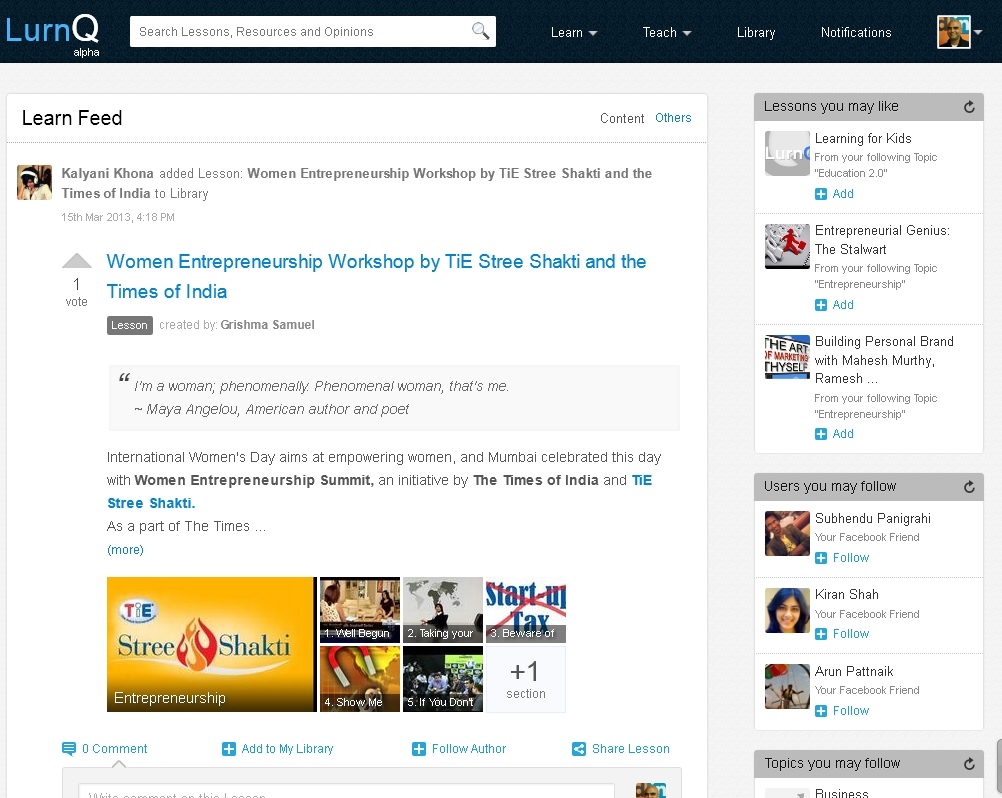 Update: Some readers have asked for information about MOOCs. A (MOOC) massive open online course is an online educational resource that is available for open access via the web. MOOCs originated around 2008 within the open educational resources (or OER) movement. For more, refer to the Wikipedia link.
Update: Some readers have asked for information about MOOCs. A (MOOC) massive open online course is an online educational resource that is available for open access via the web. MOOCs originated around 2008 within the open educational resources (or OER) movement. For more, refer to the Wikipedia link.
Online learning is undergoing a paradigm shift and this Forbes article is a pointer of the shape of things to come. Coursera, Khan Academy, Udacity, Udemy etc are growing into large public platforms and likely to give competition to universities and colleges in the years to come.
LurnQ is an Indian startup that is building a personalised learning management solution which can aggregate and curate content from the web. The key part of LurnQ replicates an experience that everyone is familiar with – using a user’s preferences to aggregate content from the web and display it like a Facebook newsfeed (see screenshot). This is a smart strategy and takes advantage of the the benefits of recognition (rather than recall).
The LurnQ platform consists of different applications that are bundled together into a SaaS platform. The core of the platform is a repository of web content from established MOOC sources like Coursera, Udacity, Khan Academy etc. There is a learning app that displays content in multiple formats – video, slides, multimedia. And a teaching app that gives teacher the capability to put together a course.
 The site has over 5000 registered users and is growing socially over 100% every month via Facebook (without ads). They also run a student ambassador program. And here’s a list of LurnQ lessons if you want to check them out.
The site has over 5000 registered users and is growing socially over 100% every month via Facebook (without ads). They also run a student ambassador program. And here’s a list of LurnQ lessons if you want to check them out.
For monetization, LurnQ is aiming Freemium. The core consumer product will remain free at all times for learners and teachers. A premium version will be available for private or closed community deployment by individuals and organizations. Pricing details are still in the works.
For targeting growth, LurnQ plans to extend the Student Ambassador Program and drive teacher side adoption through special initiatives aimed at teachers. On the application front, they want to focus on viral features (follow lessons, users, Invite friends etc). Also possible is the route of content partnership with conferences. Mobile apps are planned at a later stage to drive on the go consumption across devices.
LurnQ looks like a refreshing idea and a spin on what others are doing in the MOOC space. The first challenge they face is getting to a threshold for their user base. The adoption of the newsfeed as a core experience is likely to help in viral growth. Though the homepage is a logged in experience and departs from the design pattern that characterises Web 2.0 user generated content platforms… this might prove an impediment to quick user acquisition.
Here’s wishing them the best in their efforts.

